
Saint Paul is the capital of the U.S. state of Minnesota and the county seat of Ramsey County. Situated on high bluffs overlooking a bend in the Mississippi River, Saint Paul is a regional business hub and the center of Minnesota's government. The Minnesota State Capitol and the state government offices all sit on a hill close to the city's downtown district. One of the oldest cities in Minnesota, Saint Paul has several historic neighborhoods and landmarks, such as the Summit Avenue Neighborhood, the James J. Hill House, and the Cathedral of Saint Paul. Like the adjacent city of Minneapolis, Saint Paul is known for its cold, snowy winters and humid summers.
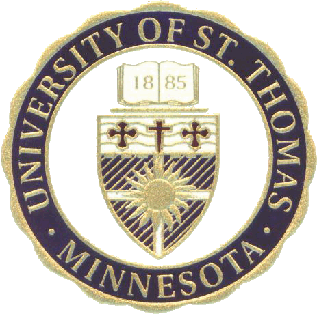
The University of St. Thomas is a private Roman Catholic university in St. Paul and Minneapolis, Minnesota. Founded in 1885 as a Catholic seminary, it is named after Thomas Aquinas, the medieval Catholic theologian and philosopher who is the patron saint of students. As of fall 2021, St. Thomas enrolled 9,347 students, making it Minnesota's largest private, nonprofit university.

Cray Plaza, located in the Lowertown neighborhood of Saint Paul, Minnesota, United States, provides space for working, living, eating, and recreating on one square city block opened in 1986.

The Archdiocese of Miami is a Latin Church archdiocese of the Catholic Church in South Florida in the United States. It is the metropolitan see for the Ecclesiastical Province of Miami, which covers all of Florida.
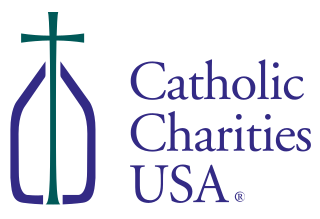
Catholic Charities USA is the national voluntary membership organization for Catholic Charities agencies throughout the United States and its territories. Catholic Charities USA is a member of Caritas Internationalis, an international federation of Catholic social service organizations. Catholic Charities USA is the national office of 167 local Catholic Charities agencies nationwide.

Minneapolis, officially the City of Minneapolis, is a city in the state of Minnesota and the county seat of Hennepin County. As of the 2020 census the population was 429,954, making it the largest city in Minnesota and the 46th-most-populous in the United States. Nicknamed the "City of Lakes", Minneapolis is abundant in water, with thirteen lakes, wetlands, the Mississippi River, creeks, and waterfalls. Minneapolis has its origins as the 19th century lumber and flour milling capitals of the world, and, to the present day, preserved its financial clout. It occupies both banks of the Mississippi River and adjoins Saint Paul, the state capital of Minnesota.
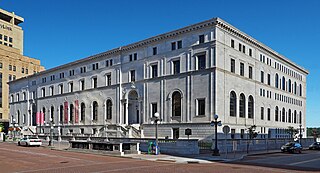
The Saint Paul Public Library is a library system serving the residents of Saint Paul, Minnesota, in the United States. The library system includes a Central Library, twelve branch locations, and a bookmobile. It is a member of the Metropolitan Library Service Agency, a consortium of eight Twin Cities library systems.
The Riverview Corridor is a transit corridor connecting Downtown Saint Paul and the Mall of America in Bloomington via the Minneapolis-Saint Paul International Airport. The corridor serves an area from the Saint Paul Union Depot to the Mall via parts of the Metro Green Line and the Metro Blue Line, and a route running parallel to West 7th Street, which runs southwest from Downtown Saint Paul. The corridor creates a triangle connecting opposite ends of the Blue Line and Green Line.

Saint Paul is the second largest city in the U.S. state of Minnesota, the county seat of Ramsey County, and the state capital of Minnesota. The origin and growth of the city were spurred by the proximity of Fort Snelling, the first major United States military installation in the area, as well as by the city's location on the northernmost navigable port of the Upper Mississippi River.

Skyline Tower is a large low-income high rise apartment complex in Saint Paul, Minnesota, United States. The building is also often called St. Anthony Tower, or 1247 St. Anthony. At 240 feet (73 m) it is the largest single HUD-subsidized building in Minnesota, and the 22nd-tallest building in Saint Paul. With over 500 units it is the largest single-building subsidized housing complex in the U.S. west of Chicago. The building is run by CommonBond Communities, the largest developer or owner of affordable rental housing in Minnesota. The nonprofit bought the building in 2000 with the help of U.S. Bank. The building was previously owned by Skyline Towers Co and managed by Sentinel Management Co.
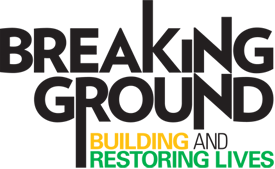
Breaking Ground, formerly Common Ground, is a nonprofit social services organization in New York City whose goal is to create high-quality permanent and transitional housing for the homeless. Its philosophy holds that supportive housing costs substantially less than homeless shelters — and many times less than jail cells or hospital rooms, and that people with psychiatric and other problems can better manage them once they are permanently housed and provided with services. Since its founding in 1990 by Rosanne Haggerty, the organization has created more than 5,000 units of housing for the homeless. "This is about creating a small town, rather than just a building," according to Haggerty. "It's about a real mixed society, working with many different people." Haggerty left the organization in 2011 to found Community Solutions, Inc. Brenda Rosen was promoted from Director, Housing Operations and Programs to Executive Director, and has led the organization since.
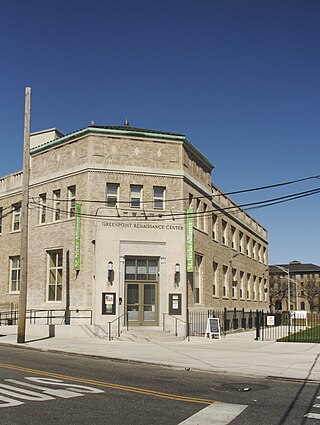
The Greenpoint Renaissance Enterprise Corporation (GREC) is a consortium of neighborhood organizations in North Brooklyn that serves to facilitate and advocate the activities for city initiatives, as well as coordinate community involvement in the neighborhood of the former Greenpoint Hospital Complex.

The San Francisco Bay Area comprises nine northern California counties and contains four of the ten most expensive counties in the United States. Strong economic growth has created hundreds of thousands of new jobs, but coupled with severe restrictions on building new housing units, it has resulted in an extreme housing shortage which has driven rents to extremely high levels. The Sacramento Bee notes that large cities like San Francisco and Los Angeles both attribute their recent increases in homeless people to the housing shortage, with the result that homelessness in California overall has increased by 15% from 2015 to 2017. In September 2019, the Council of Economic Advisers released a report in which they stated that deregulation of the housing markets would reduce homelessness in some of the most constrained markets by estimates of 54% in San Francisco, 40 percent in Los Angeles, and 38 percent in San Diego, because rents would fall by 55 percent, 41 percent, and 39 percent respectively. In San Francisco, a minimum wage worker would have to work approximately 4.7 full-time jobs to be able to spend less than 30% of their income on renting a two-bedroom apartment.
Wapato Corrections Facility is a building that was originally built as a Multnomah County jail in 2003 in the heavy industrial area of St. Johns neighborhood of Portland. It has never been put into service as a jail and was kept vacant until it was repurposed into the Bybee Lakes Hope Center, which opened in October 2020. It is the largest homeless shelter in Oregon.

Fort Snelling is an unorganized territory of Hennepin County in the U.S. state of Minnesota. It is named after historic Fort Snelling, which is located within its boundaries. The district also includes Coldwater Spring park, Minneapolis-Saint Paul International Airport, parts of the Mississippi National River and Recreation Area, and several government facilities. As of the 2020 census the territory had a population of 322 people.
Blanchet House is a non-profit social services organization located in Portland, Oregon providing meals, transitional shelter, drug and alcohol recovery programs, and support services to those struggling with homelessness and addiction. As a House of Hospitality, Blanchet House offers hot meals without question six days a week, three times a day. Blanchet House was founded in 1952 by a group of University of Portland students encouraged by their priest to "get out in the streets and help."
Steve Minn is the former Minority Leader of the Minneapolis City Council, former appointed state official, and is vice president and chief financial manager of Lupe Development, a real estate development company in the Minnesota Twin Cities area.

TRIA Rink is an ice hockey arena and practice facility in Saint Paul, Minnesota. It is located on the fifth floor of Treasure Island Center, a former Macy’s department store in downtown St. Paul. The arena was constructed as part of a redevelopment effort by the Saint Paul Port Authority who is redeveloping the building. The arena is the practice facility of the Minnesota Wild of the National Hockey League and the former home arena of the Minnesota Whitecaps of the Premier Hockey Federation and Hamline University's hockey program.

The U.S. city of Minneapolis featured officially and unofficially designated camp sites in city parks for people experiencing homelessness that operated from June 10, 2020, to January 7, 2021. The emergence of encampments on public property in Minneapolis was the result of pervasive homelessness, mitigations measures related to the COVID-19 pandemic in Minnesota, local unrest after the murder of George Floyd, and local policies that permitted encampments. At its peak in the summer of 2020, there were thousands of people camping at dozens of park sites across the city. Many of the encampment residents came from outside of Minneapolis to live in the parks. By the end of the permit experiment, four people had died in the city's park encampments, including the city's first homicide victim of 2021, who was stabbed to death inside a tent at Minnehaha Park on January 3, 2021.















